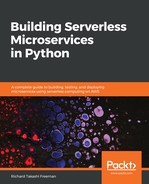The bounded context, and the fact that this is a very small code base, allow you to build very frequently and deploy very frequently. In addition, you can scale these services independently. There's usually one application server or web server per microservice. You can obviously scale it out very quickly, just for the specific service that you want to. In addition, you can have frequent builds that you test more frequently, and you can use any type of language, database, or web app server. This allows it to be a polygon system. The bounded context is a very important as you can model one domain. Features can be released very quickly because, for example, the customer services microservice could actually control all changes to the data, so you can deploy these components a lot faster.
However, there are some drawbacks to using a microservices architecture. First, there's a lot of complexity in terms of distributed development and testing. In addition, the services talk a lot more, so there's more network traffic. Latency and networks become very important in microservices. The DevOps team has to maintain and monitor the time it takes to get a response from another service. In addition, the changing of responsibilities is another complication. For example, if we're splitting up one of the bounded contexts into several types of sub-bounded context, you need to think about how that works within teams. A dedicated DevOps team is also generally needed, which is essentially there to support and maintain much larger number of services and machines throughout the organization.
